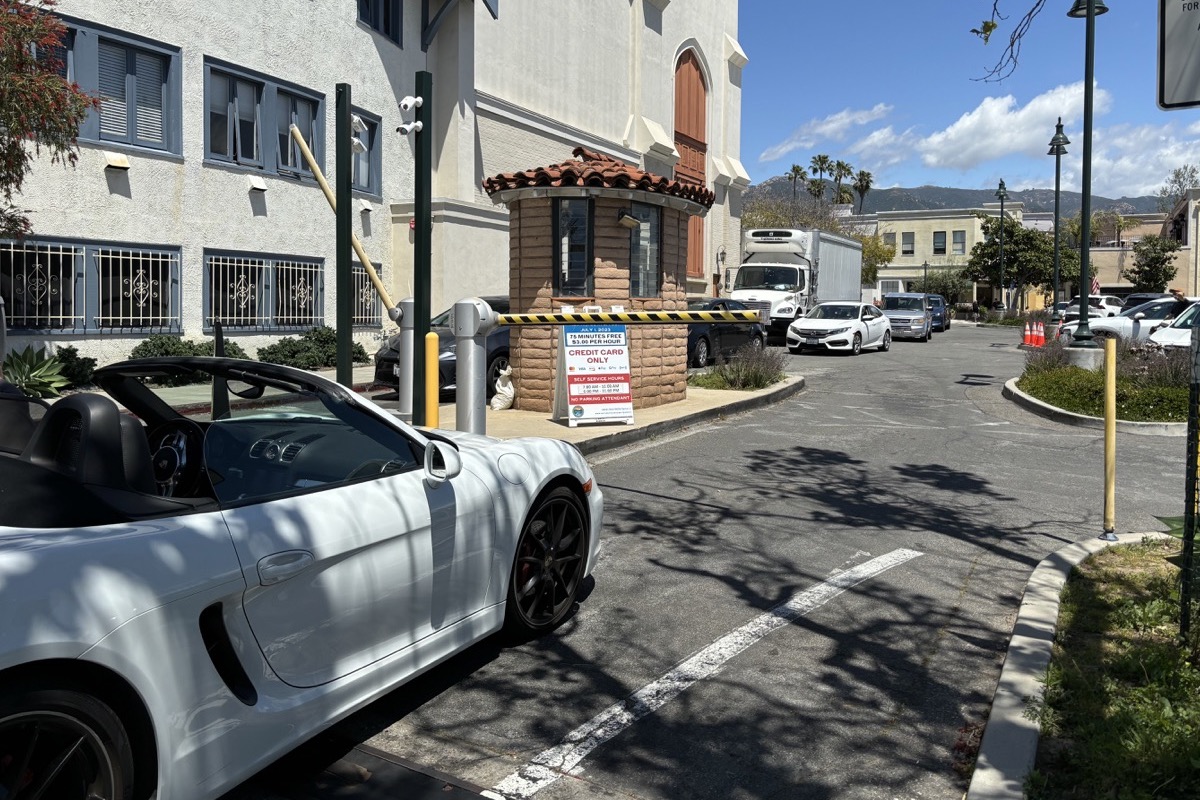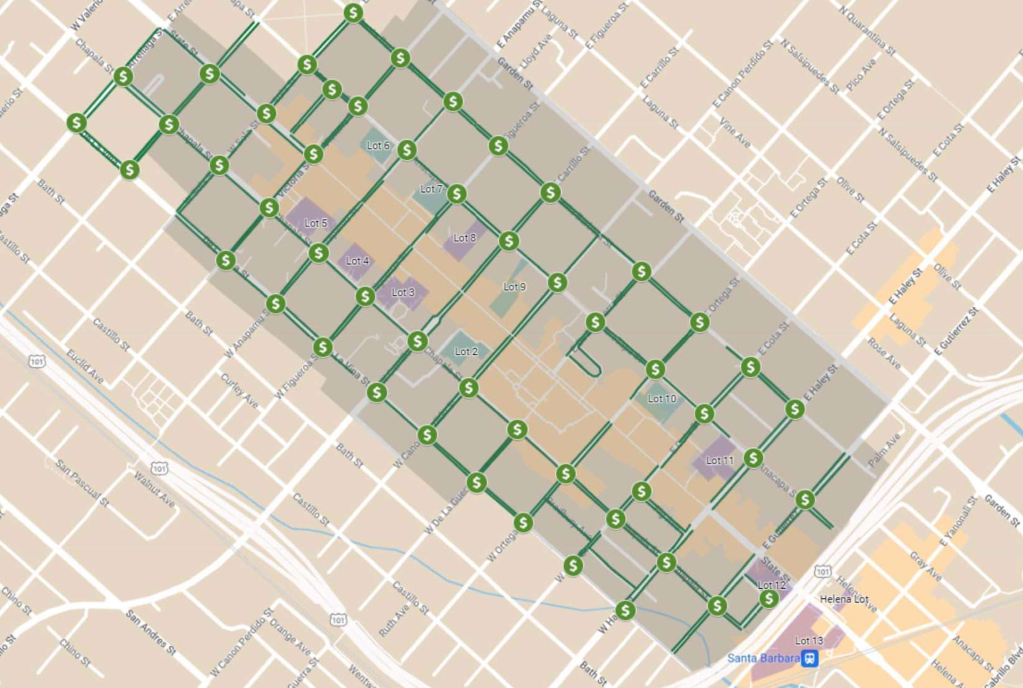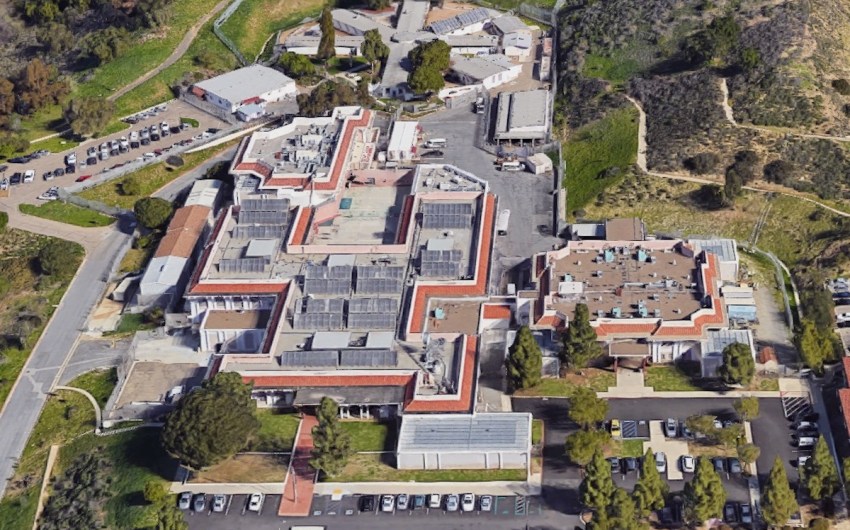Santa Barbara Proposes Big Changes to Downtown Parking Rates
Proposed Changes, Including Paid On-Street Parking, Could Help Alleviate City’s Budget Deficit

Some big changes could soon shake up how drivers pay for parking in downtown Santa Barbara.
The city is expecting at least a $7.1 million deficit in Fiscal Year 2025, and budget deliberations have already revealed some of the city’s plans to counter the dwindling revenues and growing expenses across the board. One of those plans, which according to city staff estimates may help the city save up to $3 million, is a broad restructuring of the Downtown Parking program, including a proposal to charge for on-street parking for the first time in city history.
According to a report that will be presented to the Finance Committee on Tuesday, April 30, the use of downtown’s paid parking lots has “substantially lowered” in recent years, and despite hourly fee increases in both 2023 and 2024 bringing a slight bump in revenue, the continued costs of the Downtown Parking operation and maintenance have forced the city to dip into a deficit and use up reserve funds for several years. And each year, the revenue shortfall grows and the reserve funds are depleted. By the end of 2025, without any changes, the program’s deficit would exhaust the Downtown Parking Fund’s reserves, and the city would need a “substantial subsidy” from its general fund.
The city would change each aspect of downtown parking, from the garages and surface lots to the on-street parking and employee permits. The council would also need to defer $2.1 million worth of other projects, including repairs to the Amtrak building, road improvements, and a new revenue control system.
In garages and lots, where the city has traditionally offered a subsidized free parking period, more than 60 percent of transactions are free, with most customers “hurrying back to their vehicles to avoid paying for parking,” according to the report. This has also encouraged drivers to opt for the free on-street parking spots, which are located closer to destinations and more desirable for customers.
The changes would shorten the free-parking period in garages from 75 to 60 minutes, with a charge of $2 per hour for each hour after and a $10 daily maximum. In surface lots, the free period would be cut to 15 minutes, with a $1.50 charge for every 15 minutes afterward and no daily maximum limit. These changes would hopefully encourage long-term parkers in the larger garages, while creating more turnover for available spaces in the popular surface lots. The city is projecting that this could net an additional $109,000 in revenue for garage parking and $1.4 million for surface lots.
Perhaps the most drastic change would be the transition to paid parking on the streets immediately surrounding downtown, where drivers historically enjoyed 75 to 90 minutes of free parking. According to the new plan, these on-street spots would now be 15 minutes free with a $0.75 charge for every 15 minutes after. Customers will have to enter their own license plate into a mobile app, website, or self-serve kiosk and select the length of their stay. Vehicles that do not pay or overstay their allotted time will be identified, and the city will issue “fee-due notices” to collect payment.
The change in on-street parking is due to the “significant” amount of money expended on maintaining on-street parking, which does not bring any revenue at the moment.
A new model is needed, the report says, to ensure the financial sustainability of the downtown parking program, improve parking turnover and availability for customers, decrease the cost of employee parking, and encourage visitors to stay longer.

These parking fees will be enforced seven days a week from 8 a.m. to 8 p.m., “with possible seasonal adjustments for daylight,” according to the report, on surface streets immediately surrounding the downtown area (click here for a map of payment zones). This change could, according to Downtown Parking staff, bring in up to $2.5 million in additional revenue.
In order to implement this new payment structure, the city will need to procure new pay stations, signage, payment apps and mobile web services, license-plate-recognition equipment and enforcement vehicles, and handheld devices for fee notices. The city could use existing staff to collect fees and issue notices for paid street parking.
But Councilmember Eric Friedman is cautious about the prospects of this new plan. During last week’s council meeting about the budget, he pointed out that the city was making two large assumptions. First, that the council would pass all the new downtown parking changes, and secondly, that the changes would actually translate to $3 million in savings.
“With the proposal, the question is whether the revenue would actually materialize,” Friedman said.
It’s also a smaller part of a larger problem, he said. “The real issue is, what are we gonna do as a council and a community to bring more people back downtown?” Friedman said. “We need to reimagine the downtown area.”
In the staff report, the city acknowledges that the proposal “represents a major change to longstanding prices and practices that may cause significant shifts in the behavior of parkers,” and there are some options on how to mitigate the negative impacts on local residents. One would be an incentive, similar to the Film Festival Pass, to give city residents discounted rates for special uses and rates.
But there is also a risk in the city not making the changes to parking fees. If the new rates aren’t put into place, the city might have to limit general fund spending on other departments, such as police, parks, library, or general government.
The Finance Committee will discuss the potential changes on April 30, and if approved by the City Council, the new rates for garages and surface lots will go into effect on July 1, while on-street paid parking will begin in October.
Premier Events
Sat, Nov 23
2:00 PM
Santa Barbara
Mosaic Workshop at Art & Soul
Thu, Nov 28
12:00 PM
Santa Barbara
Thanksgiving Dinner at The Harbor Restaurant
Mon, Nov 18
6:00 PM
Santa Barbara
Chaucer’s Book Talk and Signing: Afabwaje Kurian
Mon, Nov 18
7:30 PM
Santa Barbara
Lobero LIVE Presents: Mat Kearney – Headlights Home Tour
Tue, Nov 19
7:00 PM
Santa Barbara
Lecture: “Belonging on an Island – Birds, Extinction, and Evolution in Hawai’i”
Wed, Nov 20
7:30 PM
Santa Barbara
Dr. Uché Blackstock
Thu, Nov 21
5:30 PM
Santa Barbara
Koegel Autism Center Holds Neurodivergent Art Show
Fri, Nov 22
6:00 PM
Santa Barbara
Introduction to Crochet Workshop
Fri, Nov 22
7:30 PM
Carpinteria
Rod Stewart VS. Rolling Stones Tribute Show
Fri, Nov 22
9:00 PM
Santa Barbara
Numbskull Presents: Jakob’s Castle
Sat, Nov 23
7:00 AM
Santa Barbara
Nic & Joe @ Roy
Sat, Nov 23
12:00 PM
Santa Barbara
Fall 2024 Healing Arts Faire
Sat, Nov 23 2:00 PM
Santa Barbara
Mosaic Workshop at Art & Soul
Thu, Nov 28 12:00 PM
Santa Barbara
Thanksgiving Dinner at The Harbor Restaurant
Mon, Nov 18 6:00 PM
Santa Barbara
Chaucer’s Book Talk and Signing: Afabwaje Kurian
Mon, Nov 18 7:30 PM
Santa Barbara
Lobero LIVE Presents: Mat Kearney – Headlights Home Tour
Tue, Nov 19 7:00 PM
Santa Barbara
Lecture: “Belonging on an Island – Birds, Extinction, and Evolution in Hawai’i”
Wed, Nov 20 7:30 PM
Santa Barbara
Dr. Uché Blackstock
Thu, Nov 21 5:30 PM
Santa Barbara
Koegel Autism Center Holds Neurodivergent Art Show
Fri, Nov 22 6:00 PM
Santa Barbara
Introduction to Crochet Workshop
Fri, Nov 22 7:30 PM
Carpinteria
Rod Stewart VS. Rolling Stones Tribute Show
Fri, Nov 22 9:00 PM
Santa Barbara
Numbskull Presents: Jakob’s Castle
Sat, Nov 23 7:00 AM
Santa Barbara
Nic & Joe @ Roy
Sat, Nov 23 12:00 PM
Santa Barbara


























You must be logged in to post a comment.